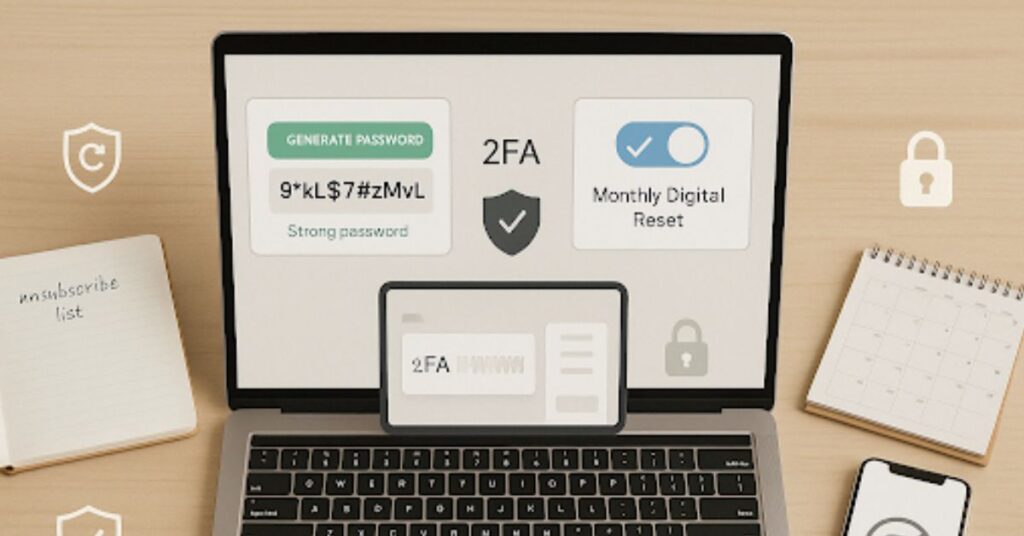Raise your hand if your password is still something like ‘P@ssword123’.
It’s okay—most of us are just trying to keep up. Between dozens of online accounts, notification overload, privacy settings we haven’t touched in years, and apps we barely remember installing, our digital lives can feel cluttered and vulnerable.
But the good news? You don’t have to become a cybersecurity expert or do a full digital detox to feel more in control. A few intentional, simple tech habits can make a huge difference. These aren’t heavy-lifting routines—they’re small changes that help you feel smarter, safer, and less stressed online.
Let’s break down five that are easy to start and easy to stick with.
Use a Password Generator to Create Strong, Unique Passwords
Weak, reused passwords are still one of the biggest risks to your online security. And let’s be honest—most of us fall into that trap, especially when websites throw requirements like:
“Must be 8–16 characters, with uppercase and lowercase letters, a number, and a special symbol.”
Instead of spending five frustrating minutes creating a password that barely meets the standard (and that you’ll forget by next week), there’s a better way — click here to use a free password generator that instantly creates strong, secure combinations for you.
These tools help you instantly generate strong, secure passwords that are complex enough to resist hacking—but easy for you to copy, paste, and save wherever you need. They’re not for storing passwords—just for generating them. Think of it as your shortcut to strong security, minus the guessing.
Popular password generators include those offered by major password management services and operating systems.
💡 Pro tip: If you want a way to store your passwords safely, you can pair the generator with a password manager. But for many, generating a strong one and storing it in your browser or offline record may be enough.
Unfollow the Noise: Clean Up Subscriptions and Online Accounts
If your inbox looks like a landfill of unread promos, and you’re still getting newsletters from a site you visited once in 2018, it’s time for a digital declutter.
Start by reviewing what you’ve subscribed to—and unsubscribe from anything you don’t actually read. You can do this manually through your email or account settings.
Next, check your old online accounts. Forgotten logins can be privacy vulnerabilities, especially if they hold personal data. Look up guides that explain how to delete unused accounts across various platforms. Cleaning up your account footprint reduces the risk of exposure and makes your digital life feel lighter.
Lock It Down with 2FA (Yes, Even for Instagram)
Two-factor authentication (2FA) adds a second layer of protection beyond your password. That means even if someone cracks your login, they can’t get in without your secondary code—often sent to your phone or generated in an app.
It may sound techy, but it’s incredibly easy to set up. And once you do, it’s hands-off.
How to enable it:
- On most platforms, go to your account settings and find the security section
- Activate two-factor authentication
- Choose your method: text message, email, or an authentication app
💡 Real-world story: A friend’s email got hacked last year—until she activated 2FA. Now even if her password is stolen, her accounts are safe.
Updates Are Your Digital Vitamins
We all love to hit “Remind Me Later” on those update notifications—but those patches aren’t just about new features. They fix security holes, too.
Running outdated software (on your phone, laptop, or even smart TV) leaves you open to vulnerabilities that hackers actively look for.
Here’s what to do:
- Turn on auto-updates for your devices and apps whenever possible
- Prioritize updates for your browser, operating system, messaging apps, and anything connected to money or identity
- Schedule a quick monthly check-in if you prefer manual control
Updates don’t have to be annoying—they’re one of the easiest ways to stay protected.
Create a Monthly “Digital Reset” Ritual
Think of this like a self-care routine—but for your online world.
Set aside 30 minutes once a month to:
- Clear your browser cache and cookies
- Review app permissions (especially location and camera access)
- Change weak or reused passwords
- Log out of devices you no longer use
- Delete outdated apps or files
Use a digital calendar to set a recurring reminder. Add a checklist so you don’t forget what to review.
🎯 Bonus: Treat yourself after—you’ve just made your digital life safer and more organized.
Conclusion: Small Habits, Big Peace of Mind
You don’t need to overhaul your entire tech setup to feel safer online. Just a few small habits—like generating stronger passwords, using 2FA, and doing monthly privacy check-ins—can make a real impact.
Start with one today.
And if you’re looking for a quick win? Try a password generator—it takes seconds and sets you up for smarter digital security in 2025.







